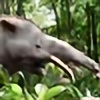HOME | DD
 Gogosardina — Hongyu chowi
Gogosardina — Hongyu chowi

#devonian #evolution #fish #fossil #hongyu #ningxia #sarcopterygian #china #paleontology #paleozoic #tetrapod #vertebrate #tetrapodomorph
Published: 2017-09-07 03:04:05 +0000 UTC; Views: 8350; Favourites: 289; Downloads: 0
Redirect to original
Description
2014+2017, acrylics on card, digital & photographyc.370,000,000, Late Devonian (Famennian), Ningxia, China (Zhongning Formation)
Illustration for Min Zhu, Per E. Ahlberg, Wen-Jin Zhao, and Lian-Tao Jia (2017) A Devonian tetrapod-like fish reveals substantial parallelism in stem tetrapod evolution. Nature Ecology & Evolution. doi:10.1038/s41559-017-0293-5
A Late Devonian riverbed on the North China microcontinent, Hongyu erupts from the sand to snack on some passing Ningxialepis. The spiny armor of these small antiarchs is of little use against snapping jaws of this voracious ambush predator.
ANIMALS IN SCENE
Hongyu chowi = Tetrapodomorph sarcopterygian, 1.5 m long. A large and very unusual lobe-finned fish known from a single well preserved specimen comprising a partial skull (unfortunately missing most of the snout), pectoral girdle and vertebrae.
The anatomy throws a spanner into tetrapodomorph phylogeny as it presents of mosaic of supposedly basal and derived characters. For example, the robust shoulder girdle, broad flattened head and the contact between the supratemporal and extratemporal bones are characteristic of rhizodonts, forms that are considered close to the base of the tetrapodomorph radiation.
On the other hand, Hongyu has a truncated hyomandibular, big plate-like scapulacoracoids and a cleithrum that lacks a ventral lamina. These are characters seen in early tetrapods and tetrapod-like elpistostegalians such as Tiktaalik. Another odd feature, not mentioned in the paper, is the absence of a bony gill cover in the holotype. The the bones may have originally been present and become lost before preservation, but this seems odd given that the delicate gill arches are still in articulation. If Hongyu truly lacked a bony operculum (as I have reconstructed here), then this is yet another tetrapod-like character.
Not surprisingly, this new fish doesn't neatly fit anywhere in the established phylogenetic models. My gut feeling is that this is an unusual basal tetrapodomorph that has independently acquired tetrapod-like characters due to anatomical specialisation as a benthic ambush predator. Then again, perhaps this discovery means that rhizodonts are closer to the origin of tetrapods than we have previously recognised.
Ningxialepis spinosa = small antiarch placoderm, 20 cm long. Jiangxilepid antiarch with serrated edges to the pectoral fins and a tall median dorsal spine.
Remigolepis major = large antiarch placoderm, 1.2 m long. Of the half-dozen or so species of Remigolepis present in the Zhongning Formation, R. major was the largest, exceeding 1 metre in length.
Related content
Comments: 9

Cool.
Is this image licensed Creative Commons? I'd like to add it to
en.wikipedia.org/wiki/Hongyu
TIA, Pete Tillman
Http://en.wikipedia.org/wiki/User:Tillman
👍: 0 ⏩: 1

Hey there
Image is currently licenced to SpringerNature. Haven't released on CC yet.
👍: 0 ⏩: 0

Excellent artwork. Is very interesting to see more of these sarcopterygians.
👍: 0 ⏩: 0
























